- Home >
- OKinawa Rail >
- About Okinawa Rail
The Okinawa Rail
The Okinawa Rail - What kind of bird is it?
In this page you can find out what the Okinawa Rail looks like and how they live.
- Okinawa Rail Gallirallus okinawae
(Family Rallidae, Order Gruiformes) - Total length ca. 35cm, body weight ca. 420g
- National natural treasure
- Endangered Species of Wild Fauna and Flora
- (the Law for the Conservation of Endangered Species of Wild Fauna and Flora)
- Critically Endangered species (Red List, Ministry of the Environment, December 2006)
- Endangered species(IUCN Red Data Book)
Short and rounded wings
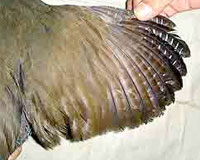 The Okinawa Rail cannot fly because their wings are small compared to their body weight, and the muscles for moving them are not well developed.
The Okinawa Rail cannot fly because their wings are small compared to their body weight, and the muscles for moving them are not well developed.
It has a beautiful pattern
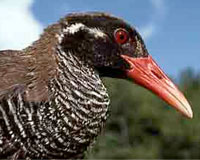 The Okinawa Rail is characterized by the black and white bars from the breast to belly, and the red bill, eyes and legs.
The Okinawa Rail is characterized by the black and white bars from the breast to belly, and the red bill, eyes and legs.
Thick and large bill
They dig out and eat small animals living in the soil. They break hard shells of snails and eat the inside.
Loud calls
They call especially in the evening. They sometimes call alternately in pairs. As they live in bushes their calls are important means of communication.
Sleep on trees
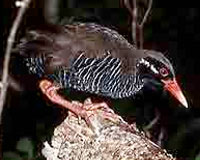 They climb trees in the evening and sleep on a thick branch growing laterally.
They climb trees in the evening and sleep on a thick branch growing laterally.
Thick and strong legs
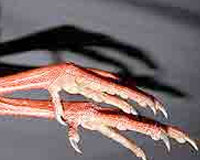 They have highly developed leg muscles compared with pectoral muscles. These legs allow them to run freely in bushes.
They have highly developed leg muscles compared with pectoral muscles. These legs allow them to run freely in bushes.
Build nests on the ground
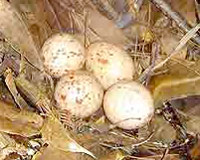 They build their simple nests using dead leaves on the ground in the forest or grassland.
They build their simple nests using dead leaves on the ground in the forest or grassland.
Lay 4 to 5 eggs
They lay 4 to 5 white eggs with brown spots in May. The length of the egg is 4.9cm and the maximum diameter is 3.7cm.
Chicks are black
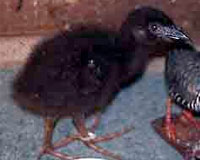 Chicks start walking soon after they hatch from the eggs. Chicks also have thick and strong legs.
Chicks start walking soon after they hatch from the eggs. Chicks also have thick and strong legs.
They only live in the forest of Yambaru
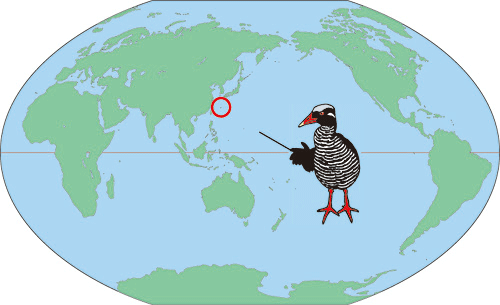
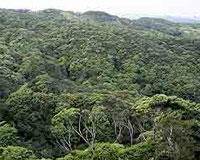
The area called "Yambaru", which contains Kunigami, Ogimi and Higashi villages of the northern Okinawa Island, has endemic species including the Okinawa Rail, Okinawa Woodpecker Sapheopipo noguchii, and Yambaru Long-armed Scarab Beetle Cheirotonus jambar. If the Yambaru forest disappears, these species will become extinct from the earth.
Small keel
Birds have highly developed pectoral muscles for flying. The bone that supports the pectoral muscles is sternal keel. In the photo below, one can find that the Okinawa Rail (left) has a larger body but a smaller keel than Buff-banded Rail Gallirallus philippensis (right), which shows that the pectoral muscles of the Okinawa Rail is not well developed. On the other hand, Okinawa Rail has large leg bones. Its skeleton shows that it is adapted to life on land.
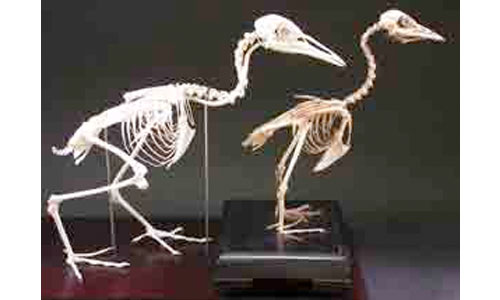
Origin of the Japanese name "Yambaru Kuina"
"Yambaru" is the name of the area which means the northern part of Okinawa Island. The Japanese name for the Okinawa Rail "Yambaru Kuina" means rail that lives in this Yambaru region. Even during the field research which led to the discovery that the bird is new to science, the research team members talked among them that if this bird proves to be a new species the Japanese name would either be "Yambaru Kuina" or "Yambaru Fumiru (Fumiru is a local name for moorhen)". On the other hand, within the Yamashina Institute there were arguments that "Okinawa Kuina" would be better as "Yambaru" is a local word little known to the public outside Okinawa Prefecture. Eventually it was named "Yambaru Kuina" as it was decided that "it is better to use the local word Yambaru in order to obtain local understanding and support, which are essential for conservation of this bird".
The word "Yambaru" had been used for Japanese names of plants and other living things before, but it was only after the naming of Yambaru Kuina (Okinawa Rail) that it became known so widely. The decline of the Okinawa Rail, the bird which, with its distinctive Japanese name, has made known nationally the precious nature that the northern Okinawa Island holds, has now become a symbol of the crisis of nature in Yambaru region.

